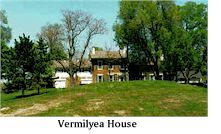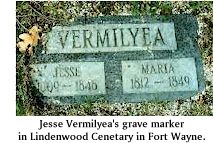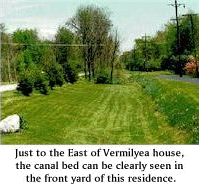 William Holgate references "Vermilliers (sic) 11 miles from Fort Wayne...log
establishment...six or seven different buildings" point to the former "Maryland
Settlement" and one of its first residents, Jesse Vermilyea. The place was along the
newly William Holgate references "Vermilliers (sic) 11 miles from Fort Wayne...log
establishment...six or seven different buildings" point to the former "Maryland
Settlement" and one of its first residents, Jesse Vermilyea. The place was along the
newly  opened canal at the Aboite River in Aboite township, Allen
county, Indiana. By stopping here, the Holgates were witnessing the last twenty days of
relative isolation for the Maryland Settlement. Within three weeks, the first waters on
the Wabash & Erie Canal would spill from Fort Wayne and rush to Huntington; a new era
would dawn. The Holgates had an easy ride upon their horses; the canal tow path was ready.
The roads in the area were difficult to maintain because of the surrounding swamp. There
was still wilderness; Indians were numerous, wolves echoed their voices throughout the wet
prairies and woodlands." opened canal at the Aboite River in Aboite township, Allen
county, Indiana. By stopping here, the Holgates were witnessing the last twenty days of
relative isolation for the Maryland Settlement. Within three weeks, the first waters on
the Wabash & Erie Canal would spill from Fort Wayne and rush to Huntington; a new era
would dawn. The Holgates had an easy ride upon their horses; the canal tow path was ready.
The roads in the area were difficult to maintain because of the surrounding swamp. There
was still wilderness; Indians were numerous, wolves echoed their voices throughout the wet
prairies and woodlands."
The arrival of a colony numbering about thirty persons,
in the spring of 1833, quite suddenly broke the solitude of the region, which had not been
disturbed by previous settlers. They cleared an area, built early style round log cabins,
cut roads, and settled in. In July 1835, there were apparently only seven families here.
The families of Enoch Turner, Richard Andrew, William Gouty, and Richard Clark, &
Jesse Vermilyea. Lot S. Bayless and Benjamin Rogers settled here with their families in
the spring of 1834. It was not until November 1835 that George Bullard arrived. Jesse
Vermilyea lived in one of the seven log homes. His was a large double-log house where
workers boarded during construction of the canal. Jesse had a small stock of goods from
which he sold to the settlers and traded with Indians; it was not a store as such, just
supplies which he kept on hand and sold. It was not until the Civil War that any other
type of store was opened in the township.
 Vermilyea is remembered as farmer,
Indian trader, canal contractor, postmaster, pioneer plank road builder, and one of the
original directors of the Fort Wayne Branch Bank, who later built the impressive Vermilyea
house. Vermilyea invested heavily in land, purchased 1600 acres, consisting of seven
different parcels. In the late 1830's and early 1840's, Jesse sold land to various
Indians; to Chapine, land at Raccoon Village, to Shappen, land at the mouth of the Aboite
River; to Mae-Shock-con-Wock- Qua, land opposite the mouth of the Aboite river. Vermilyea is remembered as farmer,
Indian trader, canal contractor, postmaster, pioneer plank road builder, and one of the
original directors of the Fort Wayne Branch Bank, who later built the impressive Vermilyea
house. Vermilyea invested heavily in land, purchased 1600 acres, consisting of seven
different parcels. In the late 1830's and early 1840's, Jesse sold land to various
Indians; to Chapine, land at Raccoon Village, to Shappen, land at the mouth of the Aboite
River; to Mae-Shock-con-Wock- Qua, land opposite the mouth of the Aboite river.
The soil underlying the area of the settlement is
excellent for brick making, and upon his farm in 1839, Vermilyea made bricks and built a
new home. It was regarded as a veritable palace at the time, and still stands on Redding
Road at the Aboite river.
The pictorial History of Fort Wayne. B.J. Griswold. 1917
I remember we stopped at the Vermilyea hotel for dinner.
They changed horses there.
Huntington Herald, Jan. 3, 1896 "Grandmother Hawley
rode in it 60 years ago."
On account of there being no places of entertainment, we
were compelled to face the storm until nightfall, when we made Jesse Vermilyea's tavern.
We found on arrival his double log house already pretty well filled, but we were cold and
hungry, and he took us in. We found him to be a very clever, gentlemanly host.
History of Wabash County, 1884. p. 106
 Ten miles below Fort Wayne, passed the
residence of Mr. Vermilyea, a wealthy farmer. His dwelling house is a splendid one - a
large two story brick building, painted white, and neatly finished, inside and out. As
they tarried here a short time to change horses, we took a strol (sic) about the grounds.
We found the garden, shrubbery, fruit trees &c finely arranged & in the best
possible order. All of the inside wood work of the house is of black walnut, highly
polished, and presents a very rich and beautiful appearance. Ten miles below Fort Wayne, passed the
residence of Mr. Vermilyea, a wealthy farmer. His dwelling house is a splendid one - a
large two story brick building, painted white, and neatly finished, inside and out. As
they tarried here a short time to change horses, we took a strol (sic) about the grounds.
We found the garden, shrubbery, fruit trees &c finely arranged & in the best
possible order. All of the inside wood work of the house is of black walnut, highly
polished, and presents a very rich and beautiful appearance.
There were three fine barns & other out
buildings corresponding. Taking it all together, it was by far the most beautiful
residence I had seen on the journey. Having obtained a drink of cold water, we returned to
the boat, and proceeded on our journey.
Through Indiana by Stage Coach & Canal Boat Indiana
Mag. of History. LXXXV, 1989
 In the canal just below the house
the channel widened out into a spacious basin in which the boats could be turned or docked
for loading and unloading. Vermilyea built a warehouse there for the benefit of the entire
neighborhood. Sometimes it was known down the line by "Ruffner's Basin" for
after the days of Vermilyea the Ruffner's occupied the place some years. The basin was
clearly outlined until the traction line was built, at which time it was filled. In the canal just below the house
the channel widened out into a spacious basin in which the boats could be turned or docked
for loading and unloading. Vermilyea built a warehouse there for the benefit of the entire
neighborhood. Sometimes it was known down the line by "Ruffner's Basin" for
after the days of Vermilyea the Ruffner's occupied the place some years. The basin was
clearly outlined until the traction line was built, at which time it was filled.
Huntington Herald. Frank S. Bash article, 1930 Interview
with Daniel W. Simmers
|